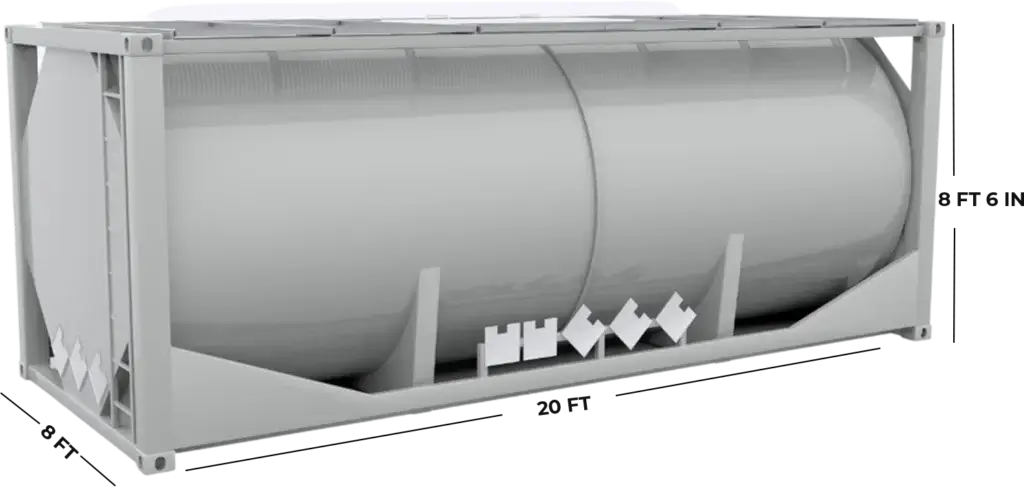
Tank containers, also called intermodal ISO tank containers, are special stainless steel shipping containers that are used for the transportation of liquids materials, gas, and powders. They can also be used for hazardous and non-hazardous products and even corrosive materials. The tank is usually fitted into an ISO frame that is manufactured according to internationally recognized standards.
These containers can be insulated or non-insulated. There are also different types:
| Container type | Usage |
|---|---|
| T1 ISO tank | used for carrying liquids like wine and spirits |
| T4 ISO tank | Non-hazardous edible and non-edible oils |
| T11 ISO tank | Non-hazardous chemicals |
| T14 ISO tank | For hazardous chemicals and acids like HCI and zinc chloride |
| T50 ISO tank | For gases such as LPG and ammonia |
| T75 ISO tank | For cryogenic gases such as helium and nitrogen. |
| Rubber-lined ISO tank container | For acid-based chemicals such as sulfuric acid and nitric acid |
| Food-grade tanks | These standard tank containers are only used to transport food products. |
| Reefer tanks | This is a refrigerated tank and can cool the contents or keep it at a constant temperature. |
| Electrical Heated Iso tanks | With Electric powered glycol pump system for heating products that need to be kept in liquid form or elevated temperature. |
| Gas tanks | used to transport gas. |
| Silo tanks | are used to transport grains. |




It can be a challenge to picture exactly how big a container can be. Here are a few everyday guidelines to help you.
| 20ft | |
|---|---|
| How much space will it take up outside? | 20ft tank containers require around 25ft of space for safe loading and unloading. Additionally, the area should be free from obstacles or any fixtures which could impede the loading processThe capacity of tank containers can differ greatly, depending on whether they are insulated or not. Insulated tanks have the potential to hold up to 26,000 liters, compared to non-insulated models which are typically limited to 25,000 liters. |
| What is it’s capacity? | The capacity of tank containers can differ greatly, depending on whether they are insulated or not. Insulated tanks have the potential to hold up to 26,000 liters, compared to non-insulated models which are typically limited to 25,000 liters. |
Here are the approximate dimensions of tank containers. The specific dimensions and the capacity will vary depending on the make and the age of the container so the measurements below are an
approximation.
| 20ft | |
|---|---|
| External dimensions | 20’’ long 8’ wide 8’6” high |
| What does it weigh empty? (Tare) | 9, 085 lbs |
| What is the maximum weight it can transport? (payload capacity) | 70,285 lbs |

Tank containers are ideal for transporting liquids, gas, and powders. There are a few specific regulations related to the contents. For example, tanks that ship food products must be labeled as “Portable Liquids Only.” And, hazardous substances should be transported in tank containers that don’t have a valve (in or outlet) that sits below the surface of the contents.
• Petrochemicals • Powders
• Fuel such as petrol, diesel, and compressed natural gas (CNG)
• Dairy products and foodstuffs
•Chemicals such as hydrogen peroxide, sulfur acid, etc
•Bulk liquid food products such as cooking and vegetable oil, etc
•Alcoholic beverages such as wine and spirits

Watch the video below by Odyssey Logistics & Technology to get an idea of what a tank container looks like.
An ISO tank container is an intermodal container designed for bulk transport of liquids, gases, or powders. It conforms to ISO standards, ensuring compatibility with different transportation methods. With a cylindrical shape, its capacity ranges from 20,000 to 26,000 liters. ISO tank containers are widely used to transport chemicals, food items, and hazardous materials.
If you’re in need of shipping container tanks, look no further than On-Site Storage Solutions. With over 20 years of experience in selling and renting new and used shipping containers, they offer a wide variety of options to meet your needs. On-Site Storage Solutions is your go-to source for high-quality storage containers. Visit their website to browse their selection and inquire about shipping container tanks.
The fuel capacity of a container tank can vary depending on its size and type. However, ISO tank containers can have capacities ranging from 14,000 liters (3,698 gallons) to 26,000 liters (6,868 gallons) or more.

Ⓒ 2024 On-site Storage Solutions | All Rights Reserved
